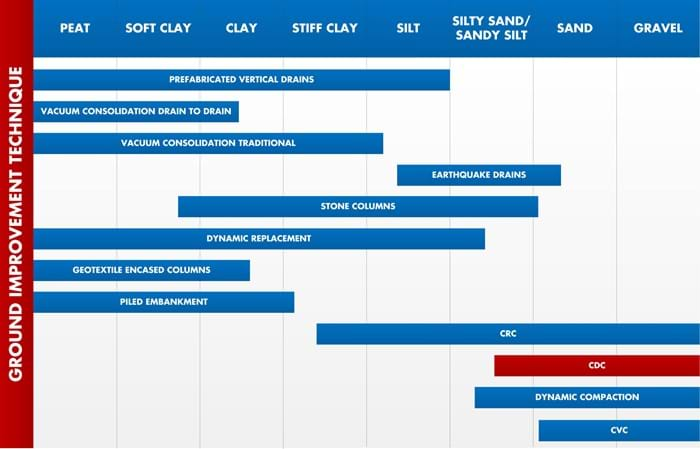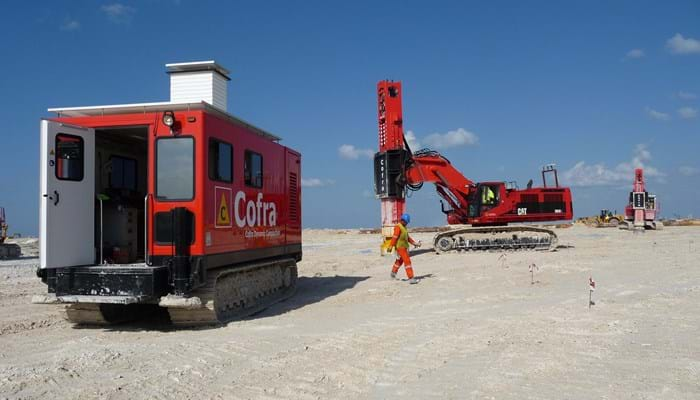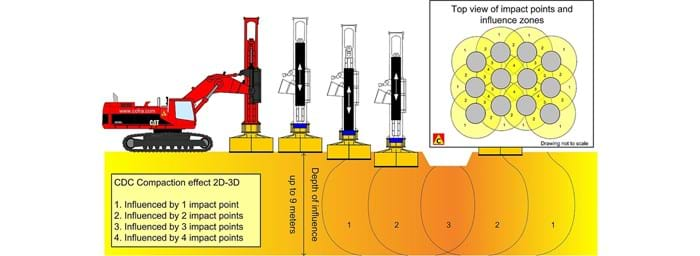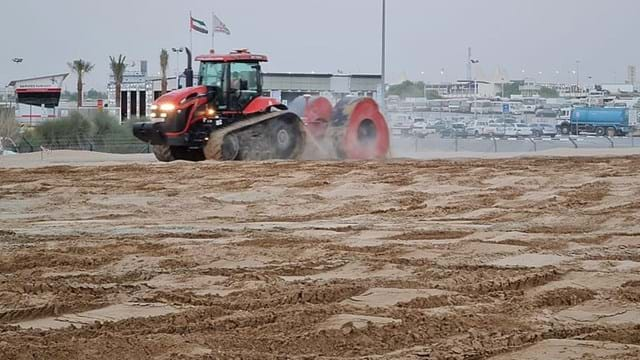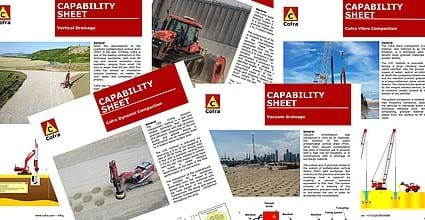With the development of the CDC technique, a rapid impact compaction (RIC) technique, Cofra has a product available, which is cheap, fast and reliable. The technique compacts the underground fast, homogeneously and with a high accuracy. Dependent on the substrata and the applied energy, the CDC technique is capable of compacting the soil till a depth of 9 meters below the surface. This is mainly due to the use of 16 tonne hammers, a state of art monitoring system and highly controlled compaction operations. The method is highly economical and is capable to compete with dynamic compaction and other rapid impact compaction techniques.
What it is
Cofra Dynamic Compaction (CDC) method, also referred to as Rapid impact compaction (RIC), is a technique that densifies loose granular materials up to a depth of 7 to 9 meters below the surface by repeatedly dropping an hydraulically accelerated weight from a height of 1.2 to 1.5m onto a foot which remains in contact with the soil. This provides a highly save and sound operational process when compared to Dynamic Compaction. We have hammer available ranging in drop weights from 9 ton up to 16 ton.
How it works
The compaction of the underground is initiated by vibrations, which lead to the rearrangement of the particles. These vibrations are generated from the impact of a weight onto the surface.
The CDC method is in essence a form of dynamic compaction in which densification is achieved by lifting and dropping a weight from a specified height. The difference is that in the case of CDC the foot remains in contact with the surface generating vibrations in the subsoil. This makes it able to compact near or under the water level. Depending on the requirements, 20 to 60 blows are given on each location. The compaction of a single point takes more or less 2 minutes.
The compaction results are, amongst others, dependent on the soil type, fines content and requirements. An assessment of the local soil by a compaction expert is therefore highly recommended. The depth of influence can be limited by density differences in the subsoil. If the situation is ideal, effects can be measured up to 9 meters deep. Improvements of up to qc=30MPa have often been achieved in the top 5 meters of the soil column
Why it's used
Compaction is required to mitigate liquefaction risks or improve the bearing capacity and settlement behavior under loading of the underground. CDC compaction is often used on new reclamations to compact the subsoil up to requirements to avoid liquefaction under an earthquake. The solution is also in high demand to improve the bearing and settlement characteristics of the top layers as the depth of influence coincides perfectly with a 3 by 3 footing.
Applying CDC will result in the following effects:
- Soil densification due to vibration and particles re‐organization
- Friction angle increase
- Stiffness increase
- Bearing capacity increase
- Liquefaction mitigation
- Limitation of settlement when applying load
Application area
Cofra Dynamic Compaction is used in the following markets (click on the specific market for more information):
- Infrastructure: The CDC technique is for example used for the compaction of embankments for roads, railways, runways and aprons for airports and port areas. The compaction can in this case be related to liquefaction mitigation but also to improve the load settlement characteristics of the substrata under dynamic loading (transport of heavy equipment or reduce the long term impact of impacts)
- Dredging and land reclamation: CDC is often used to compact reclamations up to specification
- Mining: CDC can be used to compact roadways for the heavy mining trucks or to allow for higher production in the filling of spoils.
- Construction: Cofra Dynamic compaction is used in the construction industry to compact terrains but also to investigate the areas for weak spots that need treatment, often one of our lighter hammer is used in this application
- Liquefaction mitigation: CDC is used for liquefaction mitigation in areas where loose saturated granular soil occurs up to a depth of 7 to 9 meters
The following soil types are suitable for the use of CDC:
How it is installed
The operational process of Cofra Dynamic Compaction consists of placing the foot on the marked location. After positioning, the hammer is released from the lifting frame to be able to move freely during compaction. The compaction process is started by the lifting of the weight to the predetermined height, after which the hammer is dropped onto the foot which remained in contact with the ground. This process is repeated until the stop criteria set by our geotechnical engineer are met. After completion the hammer is connected to the frame and lifted to the next compaction location. A dense grid between 2.0 and 4.0 meter is used to create homogeneous compaction.
Contact us (regional contacts on our contact page)
Business development Cofra
For new opportunities or partnering.

Estimation Department Cofra
If you require a quotation or need a budget for your project for any country in world outside our home markets.

Technical Sales Cofra
For design questions or technical information.



